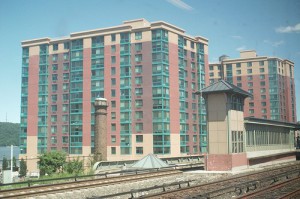If you have ever experienced back pain you often acutely focus on a problem that may exist with your spine. Only later you find out it may not be your back. Instead it could be your hips, muscles and joints which are all interconnected and are needed to support a healthy spine and quality of life. By building that support system you may even eliminate the back pain that once plagued you.
In the New York Metropolitan area, transit is the backbone. Transit-oriented development in the urban areas and the railroad suburbs surrounding each station is the core muscle which keeps 13 million New Yorkers (and 6 million in Northern New Jersey and Connecticut) moving in a productive fashion. It’s vital to the economy and quality of life downstate.
In the five boroughs, 6,300 subway cars and 5,600 buses, provide 7.7 million rides a day. Metro-North serves 121 different stations in seven New YorkState counties and two in Connecticut. On Long Island, 735 daily trains provide transportation for 265,000 each weekday. Including regional bus systems and rail connections in neighboring states, the region is the quintessential hub-and-spoke system that makes Manhattan a global center for business and the region livable for all commuters, riders and drivers. The transit system is most efficient in the places that have developed densely, with the stations located in the walkable core. Pre-1950’s development, the traditional downtown, was very similar to what we consider modern day TOD; walkable environments with the mixing of uses, retail on the ground floor, with diverse housing options and offices above.
Then came the car craze. Robert Moses’s highways and bridges facilitated suburban sprawl. Neighborhoods were built lacking interconnected streets and paths for walking, forcing everyone to drive everywhere to do just about anything. Creating more car lanes often led to paralyzing, congestion.
Focusing on TOD can solve many of the issues caused by inefficient land use in the past. A combination of personal lifestyle choice and real savings (the American Public Transit Association found that New York City families can save $14,340 annually by utilizing transit) continues to move a record number of people of all ages, socioeconomic and racial backgrounds out of the car and into the bus or train.
Benefits of Transit-Oriented Development:
- Revitalizes main streets, urban cores
- Aligns with demand for rentals and condos
- Supports existing transit service and makes possible transit enhancements
- Environmental benefits from fewer vehicle-miles-traveled
- Provides alternatives to single-family home for elderly, Gen-Y, low-income
- Tool to improve fair and affirmative housing options
The development community in the New York metro region has noticed the shift in housing demand. The effort by the Long Island Regional Economic Development Council to provide financial support for water and sewer infrastructure in places like Ronkonkoma allows for the creation of a dense town center around the LIRR station; an example of when building new infrastructure is warranted.
Efforts by the MTA Metro-North to stimulate TOD in places such as Beacon and Harrison, as well as the work by the New York and Connecticut Sustainable Communities Consortium in places such as New Rochelle, is evidence that New York is finally starting to rebuild the TOD our transit system needs.

Hudson Park in Yonkers has brought new residents to local shops and increased usage of the historic train station.
But we aren’t there yet, with more challenges to be addressed. Local policies like parking regulations, outdated zoning policies, lack of sewer infrastructure, and overly burdensome development approval processes, still push developers toward the path of least resistance: to states with comprehensive TOD strategies, or into sprawl development. Even though TOD can improve the financial situation for transit operators, the state does not have a coordinated strategy to assist with TOD planning or to defray the costs as compared to suburban development.
In part because of the higher cost of TOD in New York, many units that have been developed are luxury or higher end. This results in fewer affordable and mixed-income options. It does not adequately address the issues of displacement and gentrification. This is an unacceptable side effect as projections indicate that low-income riders are most likely to be a transit systems greatest user (by 2030 more than half of the potential demand for housing near transit will come from households below area median income).
The best examples of public support for TOD have come from local governments and states that develop holistic approaches to realizing its economic benefits while advancing social goals.
As highlighted in the 2011 report by RPA, Getting it Done, which offers strategies for Long Island to improve their TOD landscape, the City of Fairfax, VA was identified as a place that has been able to streamline the planning process for new development, creating one point of contact for all information and forms.
Two programs out west showcase the benefits of cooperation between government, non-profit and the private sector in funding TOD. The San Francisco Bay Area Transit-Oriented Affordable Housing (TOAH) Fund is a $50m public, private and non-profit collaboration for the development of affordable housing, retail space and other critical services. Eighty-five percent of the fund capital is dedicated to the creation of affordable units. The fund, which closed in 2011, included support for pre-development and acquisition among other activities that traditional financiers have shied away from.
A similar approach in Denver, the Mile High Transit Oriented Development Fund, is a $15m fund that is expected to create or preserve 1,000 affordable units. Strategic land acquisitions promise future sustainable and equitable growth.
Creating environments with access to transit for those who rely on it is important. While certainly there exist additional challenges in an intensely developed region like New York, derivatives of these programs could create an easier path forward for the type of TOD desired and needed. It’s vital to further support our transit capability, the people who rely on it, and the countless new riders across the state who are demanding it.



